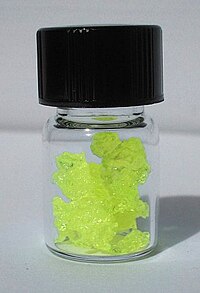Uranyl nitrate
 |
|
 |
|
| Names | |
|---|---|
|
IUPAC name
(T-4)-bis(nitrato-κO)dioxouranium
|
|
| Other names
Uranium nitrate
|
|
| Identifiers | |
|
10102-06-4 |
|
| 3D model (Jmol) | Interactive image |
| ChemSpider |
22177973 |
| ECHA InfoCard | 100.030.229 |
| UNII |
0C0WI17JYF |
|
|
|
|
| Properties | |
| UO2(NO3)2 | |
| Molar mass | 394.04 g/mol |
| Appearance | yellow-green solid hygroscopic |
| Density | 2.81 g/cm3 |
| Melting point | 60.2 °C (140.4 °F; 333.3 K) |
| Boiling point | 118 °C (244 °F; 391 K) (decomposition) |
| g/100g H2O: 98 (0°C), 122 (20°C), 474 (100°C) | |
| Solubility in tributyl phosphate | soluble |
| Hazards | |
| Safety data sheet | External MSDS |
|
EU classification (DSD)
|
|
| R-phrases | R26/28, R33, R51/53 |
| S-phrases | (S1/2), S20/21, S45, S61 |
| Flash point | Non-flammable |
| Lethal dose or concentration (LD, LC): | |
|
LDLo (lowest published)
|
12 mg/kg (dog, oral) 238 (cat, oral) |
| Related compounds | |
|
Other anions
|
Uranyl chloride Uranyl sulfate |
|
Except where otherwise noted, data are given for materials in their standard state (at 25 °C [77 °F], 100 kPa).
|
|
|
|
|
| Infobox references | |
Uranyl nitrate (UO2(NO3)2) is a water soluble yellow uranium salt. The yellow-greencrystals of dioxouranium nitrate hexahydrate are triboluminescent.
Uranyl nitrate can be prepared by reaction of uranium salts with nitric acid. It is soluble in water, ethanol, acetone, and ether, but not in benzene, toluene, or chloroform.
During the first half of the 19th century, many photosensitive metal salts had been identified as candidates for photographic processes, among them uranyl nitrate. The prints thus produced were alternately referred to as uranium prints, urbanities, or more commonly uranotypes. The first uranium printing processes were invented by a Scotsman, J. Charles Burnett, between 1855 and 1857, and used this compound as the sensitive salt. Burnett, authored an 1858 article comparing "Printing by the Salts of the Uranic and Ferric Oxides" The basis for the process lies in the ability of the uranyl ion to pick up two electrons and reduce to the lower oxidation state of uranium(IV) under ultraviolet light. Uranotypes can vary from print to print from a more neutral, brown russet to strong Bartolozzi red, with a very long tone grade. Surviving prints are slightly radioactive, a property which serves as a means of non-destructively identifying them. Several other more elaborate photographic processes employing the compound sprung up and vanished throughout the second half of the century with names like Wothlytype, Mercuro-Uranotype and the Auro-Uranium process. Uranium papers were manufactured commercially at least until the end of the 19th century, vanishing in the face of the superior sensitivity and practical advantages of the silver halides. Nevertheless, between the 1930s through the 1950s Kodak Books still described a uranium toner (Kodak T-9) using uranium nitrate hexahydrate. Some alternative process photographers including artists Blake Ferris and Robert Schramm continue to make uranotype prints today.
...
Wikipedia
